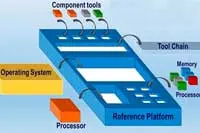 The Towards Ubiquitous Low-power Image Processing Platforms (TULIPP) project has been announced and will receive nearly €4million in funding from Horizon 2020. The initiative will target the development of high performance, energy efficient embedded systems for the growing range of image processing applications.
The Towards Ubiquitous Low-power Image Processing Platforms (TULIPP) project has been announced and will receive nearly €4million in funding from Horizon 2020. The initiative will target the development of high performance, energy efficient embedded systems for the growing range of image processing applications.
“Image processing applications stretch across an increasingly broad range of industrial domains and are reaching a higher level of complexity than ever before,” said Philippe Millet of Thales and TULIPP’s project co-ordinator. “The TULIPP reference platform will give rise to advances in system integration, processing innovation and idle power management to cope with the challenges of increasingly complex vision-based systems.”
The TULIPP consortium members include Thales (France) as the project lead and co-ordinator, with Efficient Innovation SAS (France), Fraunhofer IOSB and Ruhr-Universität Bochum (Germany), Hipperos (Belgium), Norges Teknisk-Naturvitenskapelige Universitet (Norway), Sundance Multiprocessor Technology (UK), and Synective Labs (Sweden).
TULIPP will focus on developing a reference platform for vision-based system designers that defines a set of guidelines for the selection of relevant combinations of computing and communication resources while minimising energy consumption and reducing development costs and time-to-market.
In addition, TULIPP will develop three use case demonstrators as proof-of-concept and validation of the reference platform. These use cases will include: a medical imaging surgical X-ray system designed to reduce radiation doses by 75%; a smart automotive embedded vision system for ADAS which, in addition to low-level image processing, interprets what is on the images to deliver safer driving experiences; and an embedded image processing system to create smart drones and unmanned aerial vehicles for the search and rescue of survivors at disaster incidents.
By the end of the project in 2018, TULIPP expects its work to extend by four times the peak performance per Watt of image processing applications and by 10 times the average performance per Watt.
Author
Peggy Lee
Source: www.newelectronics.co.uk

